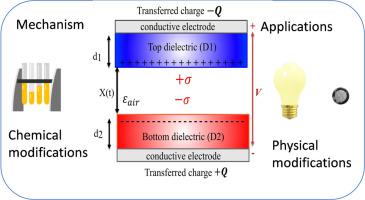Progress in Polymer Science ( IF 27.1 ) Pub Date : 2023-07-11 , DOI: 10.1016/j.progpolymsci.2023.101723 Mina Shanbedi , Haleh Ardebili , Alamgir Karim

|
Triboelectric nanogenerators (TENGs), a nascent field in energy conversion technologies, provide a novel approach to producing electrical energy from mechanical motion in the surrounding environment.Polymers play a key role in the functioning of TENGs through their exceptional triboelectric properties, with most triboelectric active materials being polymeric with negative affinity potential. Since there are many scientific issues that are not well understood yet regarding the working mechanism and fundamental issues regarding the role of polymers in TENGs, this review covers TENG fundamentals and effects of environmental parameters and provides a deep analytical analysis of important literature studies of TENGs. Although TENGs generate high voltage, their current generation is usually in the microamp range. Modifying polymer dielectric materials has been much investigated to enhance the output performance of TENGs. This article provides a comprehensive review of various polymer modification categories and associated performance enhancement with an analysis and comparison of research results to help grasp the big picture on the role of polymer modification on TENG performance. Specifically, the source of triboelectrification and updated knowledge about their working principle, and the quantified comparison of triboelectric material are discussed. Then physical nano and microstructure and the effect of TENG material shape on the output are brought into the discussion. Equally, the important role of chemical modification of triboelectric active polymer by way of categorization of methods and their effect on electricity generation is put under focus. In order to enhance the triboelectric negativity of polymer properties, it is useful to introduce chemical groups with high negativity, such as halogens. This can be achieved through several methods, including using a sulfur backbone or casting fluorinated self-assembly monolayers (SAMs), and the impact on TENGs' performance is explored. Furthermore, the addition of fillers to polymers is a proven technique for increasing their dielectric constant, which is emphasized as particularly significant.
中文翻译:

聚合物基摩擦纳米发电机:材料、表征和应用
摩擦纳米发电机 (TENG) 是能量转换技术中的一个新兴领域,它提供了一种从周围环境中的机械运动产生电能的新方法。聚合物通过其卓越的摩擦电特性在 TENG 的功能中发挥着关键作用,其中大多数摩擦电活性材料具有负亲和力的聚合物材料。由于关于聚合物在 TENG 中的作用的工作机制和基本问题尚不清楚,因此本综述涵盖了 TENG 的基本原理和环境参数的影响,并对 TENG 的重要文献研究进行了深入的分析。尽管 TENG 产生高电压,但其产生的电流通常在微安范围内。改性聚合物介电材料为了提高 TENG 的输出性能,人们进行了大量研究。本文对各种聚合物改性类别和相关性能增强进行了全面回顾,并对研究结果进行了分析和比较,以帮助全面了解聚合物改性对 TENG 性能的作用。具体来说,讨论了摩擦起电的来源及其工作原理的最新知识,以及摩擦起电材料的量化比较。然后讨论了物理纳米和微观结构以及TENG材料形状对输出的影响。同样,通过方法分类,摩擦电活性聚合物的化学改性的重要作用及其对发电的影响也受到关注。为了增强聚合物性能的摩擦电负性,引入具有高负性的化学基团,例如卤素是有用的。这可以通过多种方法来实现,包括使用硫骨架或铸造氟化自组装单层 (SAM),并探讨了对 TENG 性能的影响。此外,向聚合物中添加填料是一种经过验证的提高其介电常数的技术,这一点被强调为特别重要。



























 京公网安备 11010802027423号
京公网安备 11010802027423号